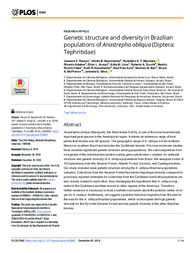Genetic structure and diversity in Brazilian populations of Anastrepha obliqua (Diptera: Tephritidae).
Genetic structure and diversity in Brazilian populations of Anastrepha obliqua (Diptera: Tephritidae).
Autoria: PASSOS, J. F.; NASCIMENTO, D. B.; MENEZES, R. S. T.; ADAIME, R.; ARAÚJO, E. L.; LIMA, K. M.; ZUCCHI, R. A.; TELES, B. R.; NASCIMENTO, R. R.; ARCE, R. R.; BARR, N. B.; MCPHERON, B. A.; SILVA, J. G.
Resumo: Anastrepha obliqua (Macquart), the West Indian fruit fly, is one of the most economically important pest species in the Neotropical region. It infests an extensive range of host plants that include over 60 species. The geographic range of A. obliqua is from northern Mexico to southern Brazil and includes the Caribbean Islands. Previous molecular studies have revealed significant genetic structure among populations. We used sequences from a fragment of the mitochondrial protein-coding gene cytochrome c oxidase I to estimate structure and genetic diversity of A. obliqua populations from Brazil. We analyzed a total of 153 specimens from the Amazon Forest, Atlantic Forest, Cerrado, and Caatinga biomes. Our study revealed weak genetic structure among the A. obliqua Brazilian populations sampled. Collections from the Amazon Forest had similar haplotype diversity compared to previously reported estimates for collections from the Caribbean and both populations are also closely related to each other, thus challenging the hypothesis that A. obliqua originated in the Caribbean and then moved to other regions of the Americas. Therefore, further evidence is necessary to draw a definite conclusion about the putative center of origin for A. obliqua. Additionally, we suggest a putative historical migration from the west to the east for the A. obliqua Brazilian populations, which could explain the high genetic diversity for this fly in the Amazon Forest and low genetic diversity in the other Brazilian biomes.
Ano de publicação: 2018
Tipo de publicação: Artigo de periódico
Unidade: Embrapa Amapa
Palavras-chave: Anastrepha obliqua, Genetic diversity, Plant pests, Praga de Planta
Observações
1 - Por padrão são exibidas publicações dos últimos 20 anos. Para encontrar publicações mais antigas, configure o filtro ano de publicação, colocando o ano a partir do qual você deseja encontrar publicações. O filtro está na coluna da esquerda na busca acima.
2 - Para ler algumas publicações da Embrapa (apenas as que estão em formato ePub), é necessário ter, no celular ou computador, um desses softwares gratuitos. Sistemas Android: Google Play Livros; IOS: iBooks; Windows e Linux: software Calibre.
Acesse outras publicações
Acesse a Base de Dados da Pesquisa Agropecuária (BDPA) para consultar o acervo completo das bibliotecas da Embrapa.

